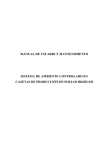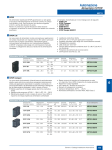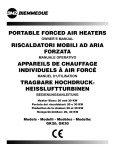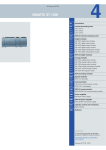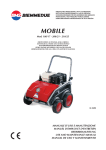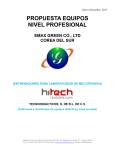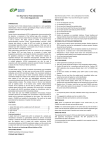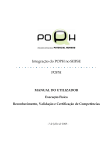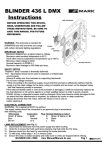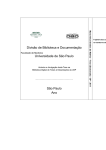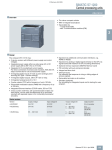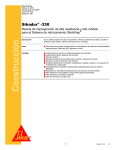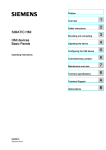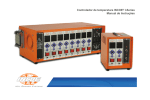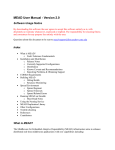Download Articulo Cientifico INGLES
Transcript
TÉCNICA DEL NORTE UNIVERSITY FACULTY OF ENGINEERING IN APPLIED SCIENCE CAREER IN MECHATRONICS ENGINEERING SCIENTIFIC ARTICLE TOPIC: DESIGN AND IMPLEMENTATION OF A CONTROL SYSTEM FOR TEMPERATURE AND HUMIDITY IN BARN CHICKEN POULTRY "LA ESPERANZA" AUTHORS: Diego Orlando Erazo Cháfuel Vanessa Tatiana Salgado Flores Ibarra – Ecuador November 2014 DESIGN AND IMPLEMENTATION OF A CONTROL SYSTEM FOR TEMPERATURE AND HUMIDITY IN BARN CHICKEN POULTRY "LA ESPERANZA" Diego Orlando Erazo Cháfuel Vanessa Tatiana Salgado Flores Mechatronic Engineer Career, Técnica del Norte University, Ibarra, Imbabura [email protected] [email protected] Summary- This work was performed with the aim of improving poultry production farm "La Esperanza", with order to generate a controlled environment system for poultry shed by automating machinery dedicated to the area of heating, ventilation and humidification; optimizing the environmental conditions in which the chicks grow, reducing the mortality rate I increased the production, using sensors and actuators on the basis of a program designed for the entire production event with determined values of temperature and moisture, according to the production day. Importantly, the implementation of this project is developed in a production of 18,000 birds. I. SITUATION ANALYSIS Poultry production in Ecuador has grown tremendously in recent years, so the farming methods seek to facilitate and improve the scale of production, for it has implemented new technologies and the implementation of automated systems. The project focuses on the design and implementation of an automated system to control temperature and humidity inside the hatchery. It plans to get the ideal environmental conditions for breeding birds, through automation and electronic control of the various devices influencing the growth process of the bird. The automation system was installed on the farm "La Esperanza", located in the area of Moronga community belonging to the parish of Malchiguí, Pedro Moncayo, Pichincha Province (temperature and humidity), the actual parameters inside the house, fuel level and water, and environmental status (levels of CO, CO2 and NH3). Also the user can stop the process control whether to perform an electronic maintenance, refueling in the heating or if they wish to clean or spraying site. All activities will be recorded by Datalogin PLC function, which will store the sensor readings of temperature, humidity, liquid level, and concentration of gases, so that at the end of the production of both the veterinarian and the owner of the farm have access to these data needed to measure the efficiency of the system. II. DESIGN AND IMPLEMENTATION OF AUTOMATION SYSTEM A. AUTOMATION SYSTEM SPECIFICATIONS. Based on the requirements for the control of temperature, humidity and air monitoring, we proceed to perform a block diagram of the instrumentation devices, control, performance, and display that will be used in the project. . A. PRINCIPAL OBJECTIVE Implement a system to monitor the temperature and humidity levels inside a chicken shed by extracting air and heating diesel, improving poultry production. B. SCOPE The project focuses on the development of a feedback control system ON / OFF with hysteresis, allowing control temperature and humidity in a chicken shed during the production event. To which sensors that measure temperature, humidity, ammonia, carbon monoxide and carbon dioxide inside the house, said data to a programmable logic controller PLC send installed, operation depends on the census, for which the heater would trigger or misting system to meet recommended. For visualization and process control have an HMI panel that allows the user to observe the recommended parameters Figure 1.-Automation System Diagram B. OPERATION OF THE SYSTEM AUTOMATION III. SELECTION OF DEVICES A. Census Stage This stage covers the sensors used in the measurement of the variables required to control the various processes of temperature, humidity, and air quality. Selected sensors are factory calibrated and a linear voltage output from 0 to 10V so it is not necessary linearization stage. PROGRAMMABLE LOGIC CONTROLLER SIMATIC S7-1200 CPU 1214C The SIMATIC S7-1200 controller is the most versatile, reliable and suitable for automation and control of any process solution as it offers a full range of control and display elements that guarantee full functionality in any field you want to implement. Analog Inputs: • Temperature Sensor • Humidity Sensor • Level Sensor • Sensor NH3 • CO Sensor • CO2 Sensor Control Stage Conformada por el controlador lógico programable y sus módulos, se encargan de la recepción de datos medidos por los sensores o los datos provenientes desde la Etapa de visualización y de acuerdo al software de programación controlan la activación de los diferentes actuadores. Actuators Stage It consists of all devices capable of changing the variables of temperature and humidity by actuation. Relays allow actuators activate either heating mode or cooling generator with hot or cold air which is able to elevate or lower the internal temperature of the house production operation. SENSORS DESCRIPTION Temperature Low TEMPERATURE Temperature high Figure 2.-PLC Siemens S7-1200 B. The digital output modules allow to increase the number of digital outputs from the controller to the process, without further investment or a significant change in the user program. ACTUATOR Heater - Heater Mode Heater - Fan Mode On Water Pump On E. Valves HUMIDITY Humidity low LEVEL WATER Level water low On Siren LEVEL FUEL Level fuel low On Siren NH3 NH3 Level high CO CO Level high CO2 CO2 Level high On Siren DIGITAL OUTPUT MODULE SM1222 Figure 3.-Digital output module SM1222 C. ANALOG INPUT MODULE SM1231 The analog input modules allow to increase the number of analog inputs to the controller of the process, without further investment or a significant change in the user program. On Siren On Siren Visualization Stage To display the status of the sensors and actuators are available from the HMI panel KTP600 along with the pilot and push the control panel lights, which allow us to observe all about the process and set or change the status of the actuators and other variables involved in the control system. Figure 4.-Analog Input Module SM1231 D. SIMATIC HMI BASIC PANEL KTP600 PN COLOR Most require control processes and control visualization method which is compact and yet efficient. Simatic HMI Basic Panels are the perfect solution slightly basic and advanced applications. Figure 7.-Heater System Diagram Figure 5.-Panel HMI KTP600 PN Color E. HEATER ARCOTHERM BIEMMEDUE FARM Mode of Operation - Fan El conmutador de activación (RV), conmuta la fase (L2) con el tele ruptor (TM) del ventilador, permitiendo activar al motor (M) de la turbina de aire, la cual absorbe aire del exterior para ser enviado al interior del galpón. The calculated thermal needs are 89104 kcal / h, to raise the temperature inside the house to the required levels. For which a diesel heater, indirect fired with a heat capacity of 90000 kcal / h, which can be used as a heater or a fan with a switch was purchased. This model corresponds to the trade name ARCOTHERM BIEMEDUE FARM 90M. Figure 6.-Heater Arcotherm Biemmedue Farm 90 Figure 8.-Fan System Diagram F. Mode of Operation - Heating The switch activation (RV), changes the phase (L2) with the thermistor (RT), which senses the temperature, if this is below the temperature set will close the contact activating diesel burner (BR). Once the combustion chamber reaches sufficient temperature the breaker Tele (TM) sensor is activated by internal heat, driving the motor (M) turbine inlet air, which is heated by contact with the combustion chamber generating hot air. The combustion gases from the chimney without contact with air entry. AIR DISTRIBUTION IN THE BARN Air distribution is carried out by a 60m long pipe with a diameter of 75cm, made of polyethylene, high heat resistance and easy handling. The pipe has small holes of 10 cm diameter at the sides of the pipe uniform allowing heated or cooled air around the warehouse distribution. The distribution pipe is retractable and can be upgraded according progresses the breeding process. This means that for one week occupy only a quarter of the house while the sixth week to completely unroll the pipe to fill the whole coop. one at a time. Manual valves are actuated by the network evolves according farm caretaker space parenting. Figure 9.-Operation Pipe Air Distribution Figure 12.-Mist System IV. IMPLEMENTATION OF THE SYSTEM A. Figure 10.-Heater System in the Barn G. DESIGN OF THE CONTROL PANEL The control panel has a simple and intuitive interface that displays user-controlled parameters and facilitates the user's manipulation of the system, allowing you to set certain variables of the control program, giving you the freedom to exercise manual control over system components. MIST SYSTEM The use of micro nebulizer into the warehouse increases the humidity, which is permanently reducing the effect of heating BIEMMEDUE FARM 90, for it is provided 2 lines of 66 meters with 25 micro sprays. Figure 11.- Misting System Schematic Each nebulizer provides micro particles sprayed water around 1m each. The valves allow pressure remains constant with fashion is expanding the shed as the days of breeding, in the early days when half of the house is concerned, only the 2 lines to the middle of the barn are enabled, for 3 weeks completely occupies the warehouse, and enables the left line first, then the right line, Figure 13.-Control panel- Front View The control panel contains all the electronic components of the control system, such as PLC (Programmable Logic Controller), the Panel HMI (Human Machine Interface), power supplies, relays, actuators, contactor, thermal relay and short circuit protection. C. WATER AND FUEL LEVEL SYSTEM The sensors were placed on top of both the water and diesel tanks these sensors are ultrasonic measurement ranges are from 15 cm to 2 m, the output is 0 - 10 v have a cone angle of ultrasonic 5th. Figure 14.-Control Panel - Interior View B. TEMPERATURE AND HUMIDITY SYSTEM Sensors Temperature and Humidity Aosong AQ3010Y are precalibrated at the factory, have a display, and has a temperature measuring range selectable from 0 to 50 C °, -20 to 80 º C and 40 to 60 º C and humidity of 0 to 95%, each with output of 0-10 V. Once you know the variables to be used for programming the sensors at the beginning and end of the shed was installed, which send to the PLC an average temperature of throughout the area for breeding. Figure 16.- Liquid Level Sensors D. GAS MONITORING SYSTEM Sensors monoxide and carbon dioxide are pointing sleeve air distribution in order to detect malfunctions of the heater, while the sensor of ammonia will be directed towards the direct down on the droppings of the house, thus accurate measurement of the aforementioned gases is ensured. Figure 17.-Gas monitoring sensors Figure 15.-Temperature and Humidity Sensor V. DEVELOPMENT OF PROGRAMMING The TIA PORTAL V11 is a new software concept implemented by Siemens, has all the necessary concepts for programming most instruments manufactured by Siemens from Programmable Logic Controllers, Variable Frequency Drives, HMI devices, Expansion Modules and Communication Modules. A. STEP 7 PROFESSIONAL MODULE The Step 7 Module Professional Tia Portal V11, enables the programming of Siemens controllers, has a powerful set of configuration tools, diagnostics, programming and simulation. Figure 20.-Flowchart of Mist Process Figure 18.-Step7 Professional Interface Figure 21.-Flowchart of Gas Monitoring Process Figure 19.- Flowchart of Heating Process B. WINCC BASIC MODULE The WinCC Basic Module allows programming of Siemens HMI panels, has a range of graphical tools among which are: Buttons, Sliders, Viewers, Pilot Lights, Images and Configuration Addressing Keyboards. Figure 24.-Temperature Control System Screen Figure 22. - WinCC Basic Interface The setting items for events, allows the operation of buttons, lights, indicators or charts when pressed, for example, a button can be configured as a switch or button depending on the event you select to activate it. Figure 25. - Humidity Control System Screen Programming imaging facilitates the organization of processes to be displayed, in addition to assigning each button a different image or function. The fields E / S allow us to view or change the PLC variables, depending on the configuration to be given as output data, input or both simultaneously. Figure 26. - Lost Bird Count Screen Figure 23.-Splash Screen Figure 27.-Gas Monitoring System Screen Figure 32.-Settings of Data Logging Screen Figure 28.- System Settings Screen VI. COST BENEFIT ANALYSIS We determine the time it takes to recoup the investment project. By performing an analysis of earnings of the manual system and automated system: A. MANUAL SYSTEM It has to cost of production is $ 61,337.76, it has a mortality rate of 10%, ie, the shed has a capacity of 18,000 chickens, this mortality rate will have 16200 birds. Figure 29.-Time Settings Screen The farmhouse "La Esperanza" delivers chickens to AVITALSA corporation where the cost per pound is $ 0.75 chickens out with an average of 5.5 pounds. Chickens = 16200 Number of units Number of pounds of chicken = 89,100 lbs Pound of chicken cost = $ 0.75 Total Sales = $ 66,825 Total Expenses = $ 61,337.76 GAIN = Total Sales - Total Expenses GAIN = 5487.24 B. Figure 30.-Temperature System Settings Screen AUTOMATIC SYSTEM It has to cost of production is $ 59,313.76 has a mortality rate of 9%, ie, the shed has a capacity of 18,000 chickens, this mortality rate will have 16380 birds. Chickens = 16380 Number of units Number of pounds of chicken = 90,090 lbs Pound of chicken cost = $ 0.75 Total Sales = $ 67567.5 Total Expenses = $ 59,313.76 GAIN = Total Sales - Total Expenses PROFIT = $ 8,253.74 Figure 31.- Mist System Settings Screen It is estimated that the investment will be recovered in 3 production periods. C. COMPARISON OF BENEFITS BASED ON COSTS characteristics, is obtained in less time and cost of labor is reduced, which can easily recover the initial investment. We can prove by the cost-benefit analysis, the project will benefit economically run on large-scale investment in turn will Within the process automation industries medium and large, we recover in very short time. recommend using the latest equipment and what may be an COST AUTOMATION BENEFIT TOTAL outstanding brand. Since they facilitate assembly work, programming and communication. Besides providing a high Implementati on Cost. $8556,63 Decreased mortality. (9%) $766,50 Future maintenance. $ 250 Production less time. DAYS) $1000 TOTAL COSTS $8806.63 in (46 IX. REFERENCES Quintana, J. (2011). Avitecnia, Manejo de las aves domesticas mas comunes (Cuarta ed.). Mexico: Trillas. Reduced heating costs $500 Reduction of labor employers. $500 TOTAL BENEFITS degree of reliability and lower cost for future maintenance. Quintana, P. (2005). Métodos Numericos con Aplicaciones en Excel. Barcelona: Reverté Ediciones. Sadiku, M. N., & Alexander, C. K. (2013). Fundamentos de circuitos eléctricos. Mexico: McGraw - Hill. $2766,50 Bolton, W. (2010). Mecatrónica, Sistemas de Control Electrónico. Barcelona: Alfaomega. Myers, R. (2012). Probabilidad y estadística para ingeniería y VII. CONCLUSIONS ciencias. México: Pearson Education. Process automation entails a substantial financial investment, but Mataix, C. (2007). Mecánica de Fluidos y Máquinas also greatly reduces the cost and time of production, takes a more Hidráulicas. Madrid: Alfaomega. precise activities performed by humans control process and Chemical Bond Approach Project. (1996). Sistemas Quimicos. ensures a higher quality product. Michigan: Reverte S.A. The project results were satisfactory, the low mortality rate of 10% with the manual system to 9% with the automated system, equivalent to an increase of 180 birds in production. Also the production time was reduced from 47 to 46 days, resulting in savings of food, water and fuel. The project investment is easily recovered due to increased earnings based on the benefits described above, the economic analysis showed that the investment is recoverable in 3 production periods, about 5 months. ABOUT THE AUTHORS Diego O. Erazo Ch., was born in Quito – Ecuador on March 31, 1990. He did his secondary education at the “Teodoro Gómez de la Torre Education Unit”. He finished his career at the “Técnica del Norte University” as Mechatronic Engineer on 2014. Interest Areas: Manufacturer Automation and Control Systems Microelectronic and Robotic, and Alternative Energies. Contact email: [email protected]. VIII. RECOMENDATIONS For the manipulation of the control system it is advisable to perform a pre-training of the farm using the user manual and maintenance annexes attached to avoid any damage to the system Vanessa T. Salgado F., was born in Cayambe – Ecuador on September 22, 1990. She did her secondary studies at the “Nelson Torres College”. She finished her career at the “Técnica del Norte University” as Mechatronic Engineer on 2014. or user integrity. Interest Areas: Automation and Control Systems, Robotic, Alternative Energies, and Microcontrollers. It is recommended to industries automate their production processes, as this ensures that the product improves its Contact email: [email protected].










